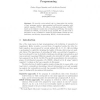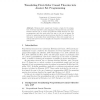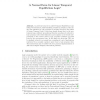3513 search results - page 42 / 703 » Super Logic Programs |
EPIA
1995
Springer
14 years 13 days ago
1995
Springer
We provide a nine-valued logic to characterize the models of logic programs under a paraconsistent well-founded semantics with explicit negation WFSX p. We define a truth-function...
CORR
2011
Springer
13 years 3 months ago
2011
Springer
Nonmonotonic causal logic, introduced by Norman McCain and Hudson Turner, became a basis for the semantics of several expressive action languages. McCain’s embedding of definit...
IFIP
1998
Springer
14 years 1 months ago
1998
Springer
A new scheduling agent for existing CIM multi-agent system is being currently developed at the Technical University of Kosice. The basic idea is to create an agent based on Schedu...
JELIA
2010
Springer
13 years 7 months ago
2010
Springer
Abstract. Nonmonotonic causal logic became a basis for the semantics of several expressive action languages. Norman McCain and Paolo Ferraris showed how to embed propositional caus...
JELIA
2010
Springer
13 years 7 months ago
2010
Springer
In previous work, the so-called Temporal Equilibrium Logic (TEL) was introduced. This formalism provides an extension of the Answer Set semantics for logic programs to arbirary the...



